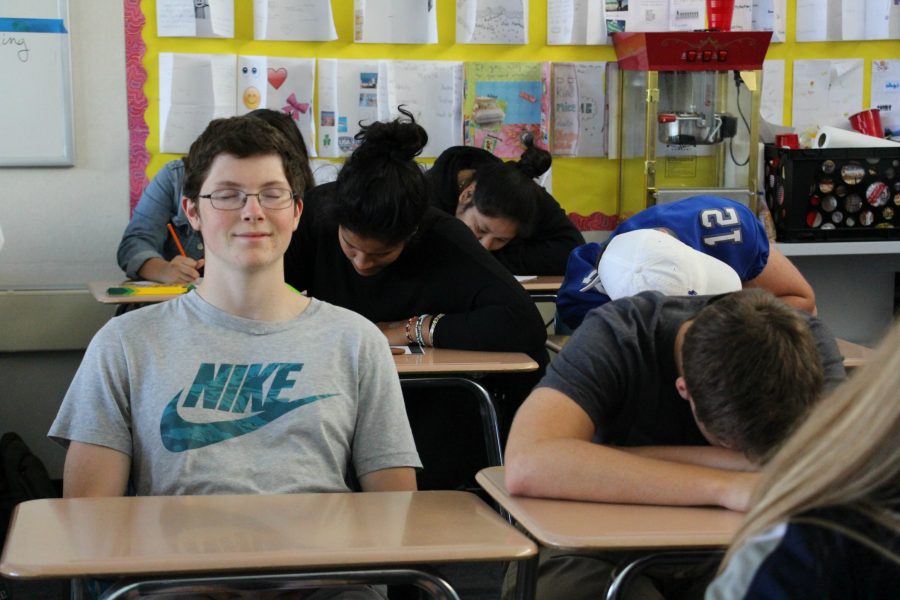Mastering Mindfulness: Teachers Learn to Destress
Senior Chris Carter meditates in Film Analysis while students color in zen coloring books and meditate around him. Film Analysis teacher Susana Herrera began the “mindful minutes” practice this year in an attempt to help her students cope better with stress. Photo by Michael Sieffert.
The smell of popcorn fills the air in room 406 as the lights dim and “Casablanca” loads on the projector. Before starting the classic, Film Analysis teacher Susana Herrera instructs her class to close their eyes. The students go quiet, already accustomed to this routine after two months of school. As kernels pop in the background, students take deep breaths and try to ignore their surroundings, and the atmosphere relaxes. After a minute of silence, the students open their eyes and the film starts.
Herrera introduced this practice of “mindful minutes” at the start of the school year to begin each class with a brief period of meditation. Hearing about companies around the Bay Area practicing similar routines inspired Herrera to introduce mindfulness into the classroom.
These practices represent the beginning of the school’s shift in focus toward mindfulness. This year, Los Altos began an optional eight-week course on mindfulness for teachers from all departments. The program intends to give teachers an understanding of the practice with the end goal of incorporating mindfulness practices like Herrera’s into their classrooms. Physician and mindfulness coach Dr. Amy Saltzman teaches the course after school on Wednesday to about 25 enrolled teachers.
Saltzman also teaches an advanced course on teaching mindfulness that Herrera currently takes. This course focuses on providing teachers with experience in mindfulness the tools to teach others and will be offered in the winter.
Each session of the introductory course typically starts with a form of mindful meditation, and English teacher Elizabeth Tompkins appreciates that the meditation focuses on finding the stillness of a moment.
“[Saltzman] always tells us to find… that moment of still before you breathe in a new breath or you let out a breath,” Tompkins said. “Even if you’re having a stressful day… you’re always breathing, so it’s nice to be able to constantly find that moment of stillness.”
Learning more about mindfulness has also aided Spanish teacher Dayana Swank in destressing from daily life.
“We live in such a fast-paced world and don’t realize how we feel or how things affect us,” Swank said. “The class has been helping me personally take a small break in my day to see how things are going… and now I’m using [mindfulness] constantly.”
As Saltzman instructs teachers on how to be more mindful, teachers plan to start incorporating mindfulness into everyday lessons. However, Saltzman advised teachers to develop their own personal practices before teaching students so that their lessons are more effective.
“You wouldn’t want someone teaching math, history or music who didn’t have a personal understanding of that topic,” Saltzman said. “That’s even more important with mindfulness because you’re teaching people how to be with their difficult thoughts and feelings.”
For English teacher Margaret Bennett, integrating mindfulness into her classes is critical. Although she taught her students about mindfulness last year, she hopes to introduce it to her classes at the start of the second quarter this year in a more structured and regular manner.
“It’s our jobs as teachers to expose kids to new things and give them a toolbox of equipment that they can use in their lives,” Bennett said. “One way to manage stress is through practicing mindfulness.”
So far, Herrera’s students have enjoyed the daily dose of mindfulness. For senior Cooper Cornell, mindfulness has been so helpful that he has used it outside of the class.
“I used it on the SAT in between sections, and it really helped calm me down,” Cooper said. “I’ve used it before games for football too, and I see myself practicing it and doing it more often [in the future].”
In addition to mindful meditation, Herrera has begun to experiment with other mindful practices such as zen coloring books in her class.
“I wanted to give people the option to do zen coloring books to get them to focus on their breathing and awareness in doing guided practice,” Herrera said. “The goal is to bring their awareness somewhere else [so they can] be with their thoughts and not have to think about sadness.”
While the course may be offered for teachers again in the near future depending on interest, in the long-term the program is intended to be self-sustaining as teachers become more familiar with mindfulness.
“I may provide support, but the idea is that over time, as teachers get more personal experience with mindfulness, they’ll be able to offer it without additional outside support,” Saltzman said.

Legend says that if you reach deep enough into the inside pocket of Danny’s leather jacket, past the hordes of pens and six-sided dice moping dejectedly,...



